| Western blot (WB): | 1:500-2000 |
| Immunohistochemistry (IHC): | 1:50-400 |
| Immunocytochemistry/Immunofluorescence (ICC/IF): | 1:50-400 |
| Flow Cytometry (Fixed): | 1:50-200 |
| (Boiling the paraffin sections in 10mM citrate buffer,pH6.0,or PH8.0 EDTA repair liquid for 20 mins is required for the staining of formalin/paraffin sections.) Optimal working dilutions must be determined by end user. | |
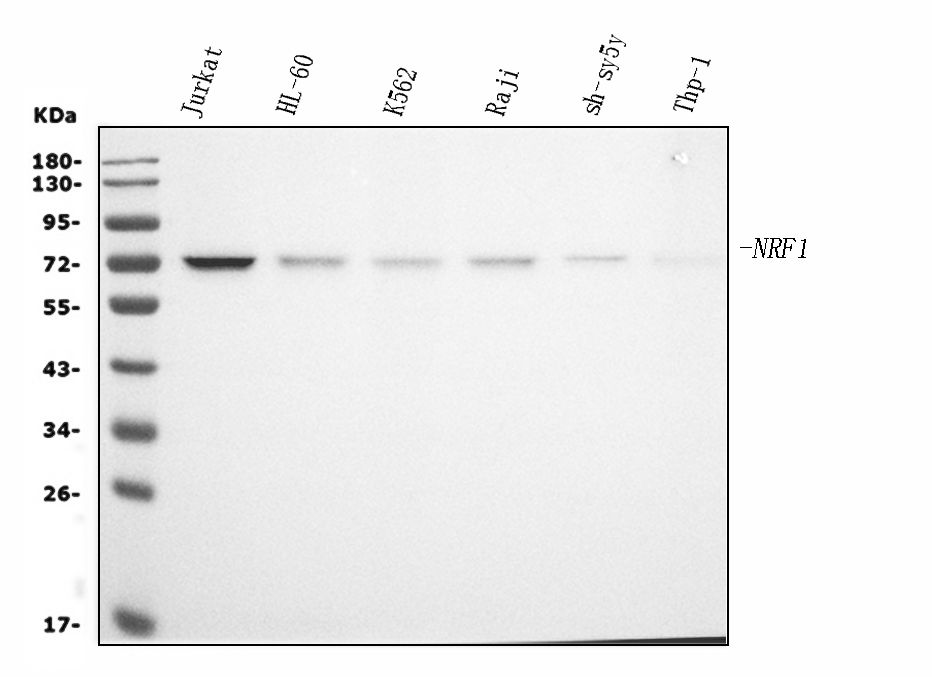
Figure 1. Western blot analysis of NRF1 using anti-NRF1 antibody (M01129-1).
Electrophoresis was performed on a 5-20% SDS-PAGE gel at 70V (Stacking gel) / 90V (Resolving gel) for 2-3 hours. The sample well of each lane was loaded with 50ug of sample under reducing conditions.
Lane 1: human K562 whole cell lysates
Lane 2: human HL-60 whole cell lysates
Lane 3: human U2OS whole cell lysates
Lane 4: human Raji whole cell lysates
Lane 5: human Caco-2 whole cell lysates
Lane 6: human HepG2 whole cell lysates
Use mouse Anti-NRF1 1:1000, probed with a goat anti-mouse IgG-HRP secondary antibody. The signal is developed using an Enhanced Chemiluminescent detection (ECL) kit (Catalog # EK1001). A specific band was detected for NRF1 at approximately 68KD. The expected band size for NRF1 is at 54KD.
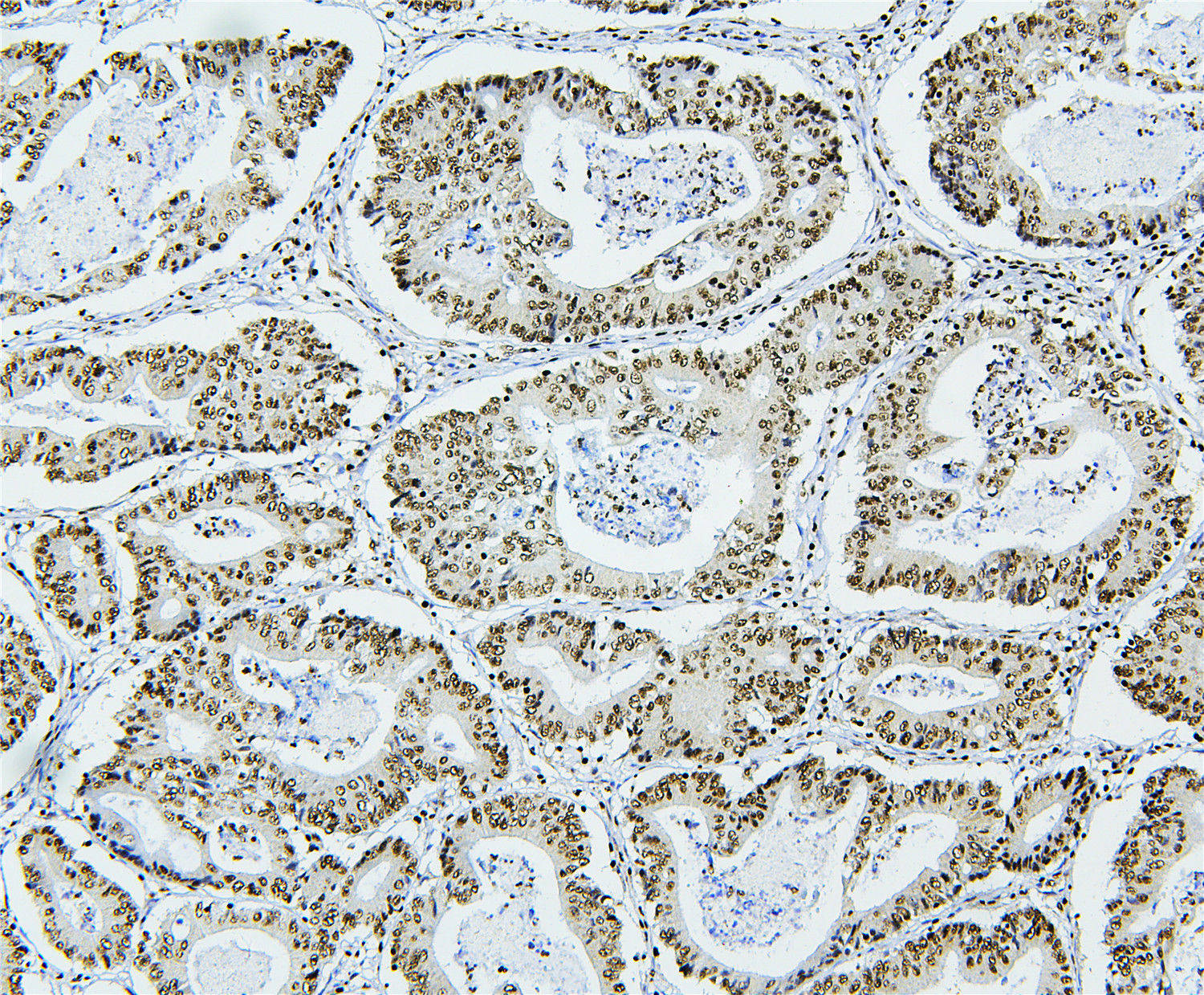
Figure 2. IHC analysis of NRF1 using anti-NRF1 antibody (M01129-1).
NRF1 was detected in paraffin-embedded section of human rectal cancer tissues. Heat mediated antigen retrieval was performed in citrate buffer (pH6, epitope retrieval solution) for 20 mins. The tissue section was blocked with 10% goat serum. The tissue section was then incubated with 1μg/ml mouse anti-NRF1 Antibody (M01129-1) overnight at 4°C. Biotinylated goat anti-mouse IgG was used as secondary antibody and incubated for 30 minutes at 37°C. The tissue section was developed using Strepavidin-Biotin-Complex (SABC)(Catalog # SA1021) with DAB as the chromogen.

Figure 3. IHC analysis of NRF1 using anti-NRF1 antibody (M01129-1).
NRF1 was detected in paraffin-embedded section of human lung cancer tissues. Heat mediated antigen retrieval was performed in citrate buffer (pH6, epitope retrieval solution) for 20 mins. The tissue section was blocked with 10% goat serum. The tissue section was then incubated with 1μg/ml mouse anti-NRF1 Antibody (M01129-1) overnight at 4°C. Biotinylated goat anti-mouse IgG was used as secondary antibody and incubated for 30 minutes at 37°C. The tissue section was developed using Strepavidin-Biotin-Complex (SABC)(Catalog # SA1021) with DAB as the chromogen.

Figure 4. IHC analysis of NRF1 using anti-NRF1 antibody (M01129-1).
NRF1 was detected in paraffin-embedded section of human mammary cancer tissues. Heat mediated antigen retrieval was performed in citrate buffer (pH6, epitope retrieval solution) for 20 mins. The tissue section was blocked with 10% goat serum. The tissue section was then incubated with 1μg/ml mouse anti-NRF1 Antibody (M01129-1) overnight at 4°C. Biotinylated goat anti-mouse IgG was used as secondary antibody and incubated for 30 minutes at 37°C. The tissue section was developed using Strepavidin-Biotin-Complex (SABC)(Catalog # SA1021) with DAB as the chromogen.
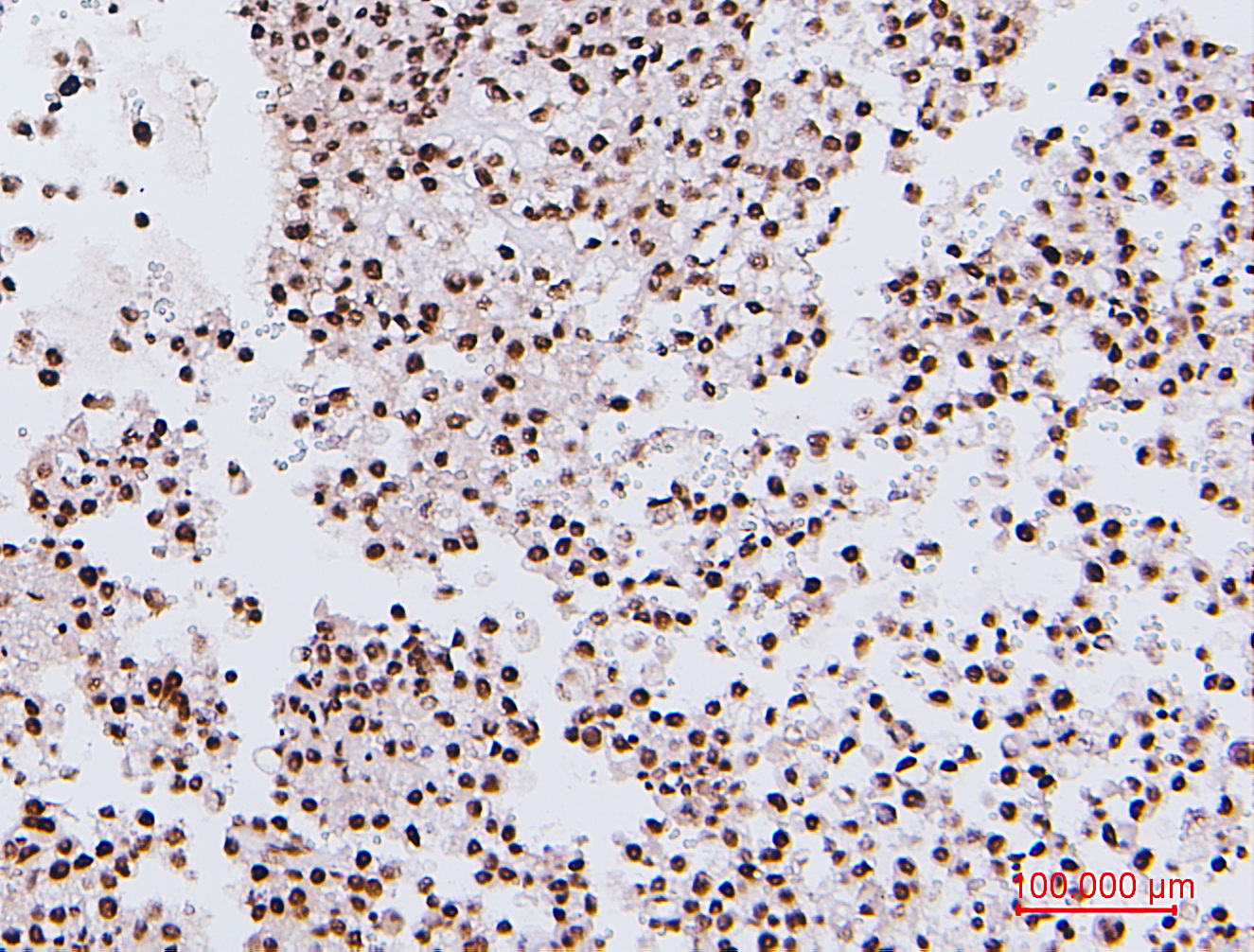
Figure 5. IHC analysis of NRF1 using anti-NRF1 antibody (M01129-1).
NRF1 was detected in paraffin-embedded section of human testis cancer tissues. Heat mediated antigen retrieval was performed in citrate buffer (pH6, epitope retrieval solution) for 20 mins. The tissue section was blocked with 10% goat serum. The tissue section was then incubated with 1μg/ml mouse anti-NRF1 Antibody (M01129-1) overnight at 4°C. Biotinylated goat anti-mouse IgG was used as secondary antibody and incubated for 30 minutes at 37°C. The tissue section was developed using Strepavidin-Biotin-Complex (SABC)(Catalog # SA1021) with DAB as the chromogen.

Figure 6. IHC analysis of NRF1 using anti-NRF1 antibody (M01129-1).
NRF1 was detected in paraffin-embedded section of human testis cancer tissues. Heat mediated antigen retrieval was performed in citrate buffer (pH6, epitope retrieval solution) for 20 mins. The tissue section was blocked with 10% goat serum. The tissue section was then incubated with 1μg/ml mouse anti-NRF1 Antibody (M01129-1) overnight at 4°C. Biotinylated goat anti-mouse IgG was used as secondary antibody and incubated for 30 minutes at 37°C. The tissue section was developed using Strepavidin-Biotin-Complex (SABC)(Catalog # SA1021) with DAB as the chromogen.

Figure 7. IHC analysis of NRF1 using anti-NRF1 antibody (M01129-1).
NRF1 was detected in paraffin-embedded section of mouse testis tissues. Heat mediated antigen retrieval was performed in citrate buffer (pH6, epitope retrieval solution) for 20 mins. The tissue section was blocked with 10% goat serum. The tissue section was then incubated with 1μg/ml mouse anti-NRF1 Antibody (M01129-1) overnight at 4°C. Biotinylated goat anti-mouse IgG was used as secondary antibody and incubated for 30 minutes at 37°C. The tissue section was developed using Strepavidin-Biotin-Complex (SABC)(Catalog # SA1021) with DAB as the chromogen.

Figure 8. IHC analysis of NRF1 using anti-NRF1 antibody (M01129-1).
NRF1 was detected in paraffin-embedded section of rat testis tissues. Heat mediated antigen retrieval was performed in citrate buffer (pH6, epitope retrieval solution) for 20 mins. The tissue section was blocked with 10% goat serum. The tissue section was then incubated with 1μg/ml mouse anti-NRF1 Antibody (M01129-1) overnight at 4°C. Biotinylated goat anti-mouse IgG was used as secondary antibody and incubated for 30 minutes at 37°C. The tissue section was developed using Strepavidin-Biotin-Complex (SABC)(Catalog # SA1021) with DAB as the chromogen.
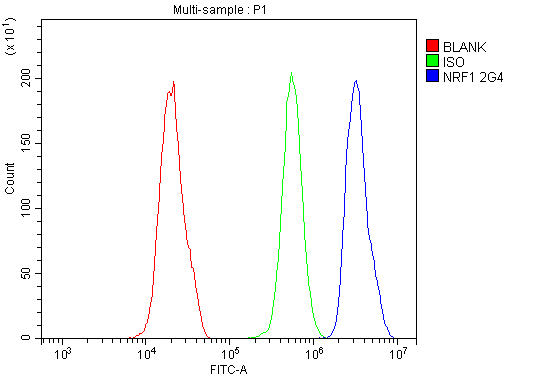
Figure 9. Flow Cytometry analysis of PC-3 cells using anti-NRF1 antibody (M01129-1).
Overlay histogram showing PC-3 cells stained with M01129-1 (Blue line).The cells were blocked with 10% normal goat serum. And then incubated with mouse anti-NRF1 Antibody (M01129-1, 1:100) for 30 min at 20°C. DyLight®488 conjugated goat anti-mouse IgG (BA1126, 1:100) was used as secondary antibody for 30 minutes at 20°C. Isotype control antibody (Green line) was mouse IgG (1:100) used under the same conditions. Unlabelled sample (Red line) was also used as a control.
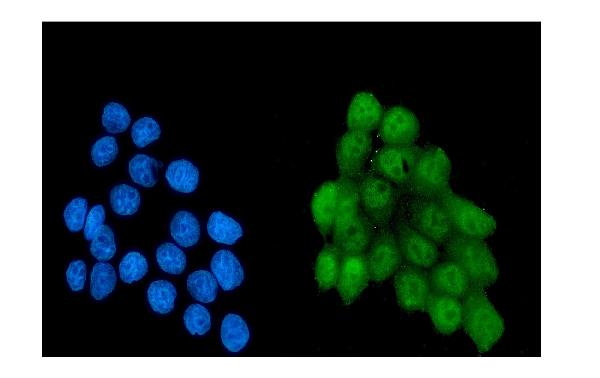
Figure 10. ICC analysis using anti-NRF1 antibody (M01129-1) was detected in immersion fixed MCF-7 cell line . Cells were stained using the Dylight488-conjugated Anti-mouse IgG Secondary Antibody (green)(Catalog#BA1127) and counterstained with DAPI (blue).

Figure 11. IHC analysis using anti-NRF1 antibody (M01129-1). detected in paraffin-embedded section of human gastric cancer tissue. conjugated goat anti-mouse IgG was used as secondary antibody. The tissue section was developed using Strepavidin-Biotin-Complex (SABC) (Catalog # SA1021) with DAB as the chromogen.

Figure 12. IHC analysis using anti-NRF1 antibody (M01129-1). detected in paraffin-embedded section of human rectal cancer tissue. conjugated goat anti-mouse IgG was used as secondary antibody. The tissue section was developed using Strepavidin-Biotin-Complex (SABC) (Catalog # SA1021) with DAB as the chromogen.

Figure 13. IHC analysis using anti-NRF1 antibody (M01129-1). detected in paraffin-embedded section of human appendicitis tissue. conjugated goat anti-mouse IgG was used as secondary antibody. The tissue section was developed using Strepavidin-Biotin-Complex (SABC) (Catalog # SA1021) with DAB as the chromogen.

Figure 14. IHC analysis using anti-NRF1 antibody (M01129-1). detected in paraffin-embedded section of human appendicitis tissue. conjugated goat anti-mouse IgG was used as secondary antibody. The tissue section was developed using Strepavidin-Biotin-Complex (SABC) (Catalog # SA1021) with DAB as the chromogen.
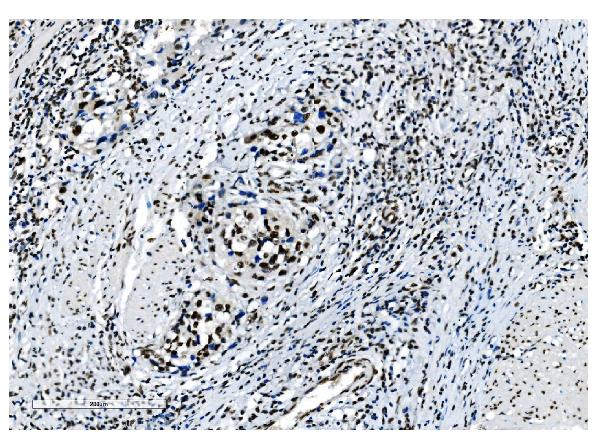
Figure 15. IHC analysis using anti-NRF1 antibody (M01129-1). detected in paraffin-embedded section of human bladder cancer tissue. conjugated goat anti-mouse IgG was used as secondary antibody. The tissue section was developed using Strepavidin-Biotin-Complex (SABC) (Catalog # SA1021) with DAB as the chromogen.
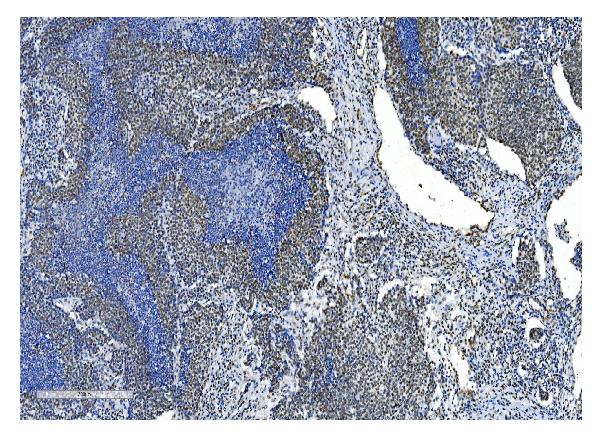
Figure 16. IHC analysis using anti-NRF1 antibody (M01129-1). detected in paraffin-embedded section of human lung cancer tissue. conjugated goat anti-mouse IgG was used as secondary antibody. The tissue section was developed using Strepavidin-Biotin-Complex (SABC) (Catalog # SA1021) with DAB as the chromogen.
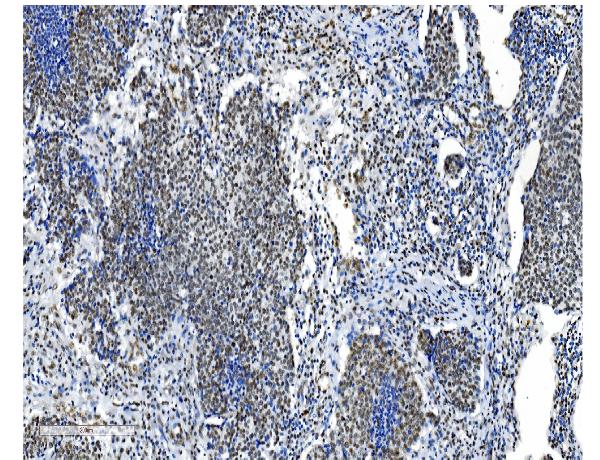
Figure 17. IHC analysis using anti-NRF1 antibody (M01129-1). detected in paraffin-embedded section of human lung cancer tissue. conjugated goat anti-mouse IgG was used as secondary antibody. The tissue section was developed using Strepavidin-Biotin-Complex (SABC) (Catalog # SA1021) with DAB as the chromogen.
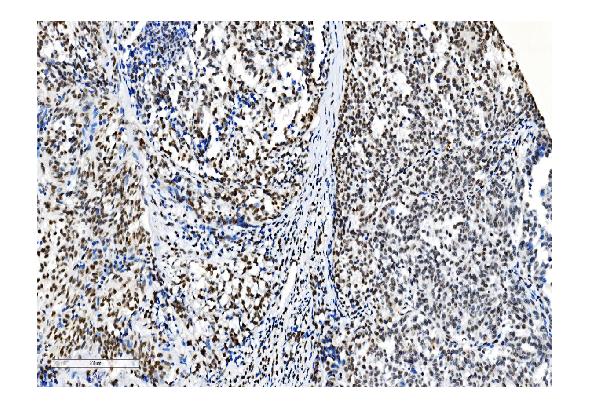
Figure 18. IHC analysis using anti-NRF1 antibody (M01129-1). detected in paraffin-embedded section of human melanoma tissue. conjugated goat anti-mouse IgG was used as secondary antibody. The tissue section was developed using Strepavidin-Biotin-Complex (SABC) (Catalog # SA1021) with DAB as the chromogen.

Figure 19. IHC analysis using anti-NRF1 antibody (M01129-1). detected in paraffin-embedded section of human ovarian cancer tissue. conjugated goat anti-mouse IgG was used as secondary antibody. The tissue section was developed using Strepavidin-Biotin-Complex (SABC) (Catalog # SA1021) with DAB as the chromogen.

Figure 20. IHC analysis using anti-NRF1 antibody (M01129-1). detected in paraffin-embedded section of human renal carcinoma tissue. conjugated goat anti-mouse IgG was used as secondary antibody. The tissue section was developed using Strepavidin-Biotin-Complex (SABC) (Catalog # SA1021) with DAB as the chromogen.

Figure 21. IHC analysis using anti-NRF1 antibody (M01129-1). detected in paraffin-embedded section of human skin cancer tissue. conjugated goat anti-mouse IgG was used as secondary antibody. The tissue section was developed using Strepavidin-Biotin-Complex (SABC) (Catalog # SA1021) with DAB as the chromogen.

Figure 1. Western blot analysis of NRF1 using anti-NRF1 antibody (M01129-1).
Electrophoresis was performed on a 5-20% SDS-PAGE gel at 70V (Stacking gel) / 90V (Resolving gel) for 2-3 hours. The sample well of each lane was loaded with 50ug of sample under reducing conditions.
Lane 1: human K562 whole cell lysates
Lane 2: human HL-60 whole cell lysates
Lane 3: human U2OS whole cell lysates
Lane 4: human Raji whole cell lysates
Lane 5: human Caco-2 whole cell lysates
Lane 6: human HepG2 whole cell lysates
Use mouse Anti-NRF1 1:1000, probed with a goat anti-mouse IgG-HRP secondary antibody. The signal is developed using an Enhanced Chemiluminescent detection (ECL) kit (Catalog # EK1001). A specific band was detected for NRF1 at approximately 68KD. The expected band size for NRF1 is at 54KD.

Figure 2. IHC analysis of NRF1 using anti-NRF1 antibody (M01129-1).
NRF1 was detected in paraffin-embedded section of human rectal cancer tissues. Heat mediated antigen retrieval was performed in citrate buffer (pH6, epitope retrieval solution) for 20 mins. The tissue section was blocked with 10% goat serum. The tissue section was then incubated with 1μg/ml mouse anti-NRF1 Antibody (M01129-1) overnight at 4°C. Biotinylated goat anti-mouse IgG was used as secondary antibody and incubated for 30 minutes at 37°C. The tissue section was developed using Strepavidin-Biotin-Complex (SABC)(Catalog # SA1021) with DAB as the chromogen.

Figure 3. IHC analysis of NRF1 using anti-NRF1 antibody (M01129-1).
NRF1 was detected in paraffin-embedded section of human lung cancer tissues. Heat mediated antigen retrieval was performed in citrate buffer (pH6, epitope retrieval solution) for 20 mins. The tissue section was blocked with 10% goat serum. The tissue section was then incubated with 1μg/ml mouse anti-NRF1 Antibody (M01129-1) overnight at 4°C. Biotinylated goat anti-mouse IgG was used as secondary antibody and incubated for 30 minutes at 37°C. The tissue section was developed using Strepavidin-Biotin-Complex (SABC)(Catalog # SA1021) with DAB as the chromogen.

Figure 4. IHC analysis of NRF1 using anti-NRF1 antibody (M01129-1).
NRF1 was detected in paraffin-embedded section of human mammary cancer tissues. Heat mediated antigen retrieval was performed in citrate buffer (pH6, epitope retrieval solution) for 20 mins. The tissue section was blocked with 10% goat serum. The tissue section was then incubated with 1μg/ml mouse anti-NRF1 Antibody (M01129-1) overnight at 4°C. Biotinylated goat anti-mouse IgG was used as secondary antibody and incubated for 30 minutes at 37°C. The tissue section was developed using Strepavidin-Biotin-Complex (SABC)(Catalog # SA1021) with DAB as the chromogen.

Figure 5. IHC analysis of NRF1 using anti-NRF1 antibody (M01129-1).
NRF1 was detected in paraffin-embedded section of human testis cancer tissues. Heat mediated antigen retrieval was performed in citrate buffer (pH6, epitope retrieval solution) for 20 mins. The tissue section was blocked with 10% goat serum. The tissue section was then incubated with 1μg/ml mouse anti-NRF1 Antibody (M01129-1) overnight at 4°C. Biotinylated goat anti-mouse IgG was used as secondary antibody and incubated for 30 minutes at 37°C. The tissue section was developed using Strepavidin-Biotin-Complex (SABC)(Catalog # SA1021) with DAB as the chromogen.

Figure 6. IHC analysis of NRF1 using anti-NRF1 antibody (M01129-1).
NRF1 was detected in paraffin-embedded section of human testis cancer tissues. Heat mediated antigen retrieval was performed in citrate buffer (pH6, epitope retrieval solution) for 20 mins. The tissue section was blocked with 10% goat serum. The tissue section was then incubated with 1μg/ml mouse anti-NRF1 Antibody (M01129-1) overnight at 4°C. Biotinylated goat anti-mouse IgG was used as secondary antibody and incubated for 30 minutes at 37°C. The tissue section was developed using Strepavidin-Biotin-Complex (SABC)(Catalog # SA1021) with DAB as the chromogen.

Figure 7. IHC analysis of NRF1 using anti-NRF1 antibody (M01129-1).
NRF1 was detected in paraffin-embedded section of mouse testis tissues. Heat mediated antigen retrieval was performed in citrate buffer (pH6, epitope retrieval solution) for 20 mins. The tissue section was blocked with 10% goat serum. The tissue section was then incubated with 1μg/ml mouse anti-NRF1 Antibody (M01129-1) overnight at 4°C. Biotinylated goat anti-mouse IgG was used as secondary antibody and incubated for 30 minutes at 37°C. The tissue section was developed using Strepavidin-Biotin-Complex (SABC)(Catalog # SA1021) with DAB as the chromogen.

Figure 8. IHC analysis of NRF1 using anti-NRF1 antibody (M01129-1).
NRF1 was detected in paraffin-embedded section of rat testis tissues. Heat mediated antigen retrieval was performed in citrate buffer (pH6, epitope retrieval solution) for 20 mins. The tissue section was blocked with 10% goat serum. The tissue section was then incubated with 1μg/ml mouse anti-NRF1 Antibody (M01129-1) overnight at 4°C. Biotinylated goat anti-mouse IgG was used as secondary antibody and incubated for 30 minutes at 37°C. The tissue section was developed using Strepavidin-Biotin-Complex (SABC)(Catalog # SA1021) with DAB as the chromogen.

Figure 9. Flow Cytometry analysis of PC-3 cells using anti-NRF1 antibody (M01129-1).
Overlay histogram showing PC-3 cells stained with M01129-1 (Blue line).The cells were blocked with 10% normal goat serum. And then incubated with mouse anti-NRF1 Antibody (M01129-1, 1:100) for 30 min at 20°C. DyLight®488 conjugated goat anti-mouse IgG (BA1126, 1:100) was used as secondary antibody for 30 minutes at 20°C. Isotype control antibody (Green line) was mouse IgG (1:100) used under the same conditions. Unlabelled sample (Red line) was also used as a control.

Figure 10. ICC analysis using anti-NRF1 antibody (M01129-1) was detected in immersion fixed MCF-7 cell line . Cells were stained using the Dylight488-conjugated Anti-mouse IgG Secondary Antibody (green)(Catalog#BA1127) and counterstained with DAPI (blue).

Figure 11. IHC analysis using anti-NRF1 antibody (M01129-1). detected in paraffin-embedded section of human gastric cancer tissue. conjugated goat anti-mouse IgG was used as secondary antibody. The tissue section was developed using Strepavidin-Biotin-Complex (SABC) (Catalog # SA1021) with DAB as the chromogen.

Figure 12. IHC analysis using anti-NRF1 antibody (M01129-1). detected in paraffin-embedded section of human rectal cancer tissue. conjugated goat anti-mouse IgG was used as secondary antibody. The tissue section was developed using Strepavidin-Biotin-Complex (SABC) (Catalog # SA1021) with DAB as the chromogen.

Figure 13. IHC analysis using anti-NRF1 antibody (M01129-1). detected in paraffin-embedded section of human appendicitis tissue. conjugated goat anti-mouse IgG was used as secondary antibody. The tissue section was developed using Strepavidin-Biotin-Complex (SABC) (Catalog # SA1021) with DAB as the chromogen.

Figure 14. IHC analysis using anti-NRF1 antibody (M01129-1). detected in paraffin-embedded section of human appendicitis tissue. conjugated goat anti-mouse IgG was used as secondary antibody. The tissue section was developed using Strepavidin-Biotin-Complex (SABC) (Catalog # SA1021) with DAB as the chromogen.

Figure 15. IHC analysis using anti-NRF1 antibody (M01129-1). detected in paraffin-embedded section of human bladder cancer tissue. conjugated goat anti-mouse IgG was used as secondary antibody. The tissue section was developed using Strepavidin-Biotin-Complex (SABC) (Catalog # SA1021) with DAB as the chromogen.

Figure 16. IHC analysis using anti-NRF1 antibody (M01129-1). detected in paraffin-embedded section of human lung cancer tissue. conjugated goat anti-mouse IgG was used as secondary antibody. The tissue section was developed using Strepavidin-Biotin-Complex (SABC) (Catalog # SA1021) with DAB as the chromogen.

Figure 17. IHC analysis using anti-NRF1 antibody (M01129-1). detected in paraffin-embedded section of human lung cancer tissue. conjugated goat anti-mouse IgG was used as secondary antibody. The tissue section was developed using Strepavidin-Biotin-Complex (SABC) (Catalog # SA1021) with DAB as the chromogen.

Figure 18. IHC analysis using anti-NRF1 antibody (M01129-1). detected in paraffin-embedded section of human melanoma tissue. conjugated goat anti-mouse IgG was used as secondary antibody. The tissue section was developed using Strepavidin-Biotin-Complex (SABC) (Catalog # SA1021) with DAB as the chromogen.

Figure 19. IHC analysis using anti-NRF1 antibody (M01129-1). detected in paraffin-embedded section of human ovarian cancer tissue. conjugated goat anti-mouse IgG was used as secondary antibody. The tissue section was developed using Strepavidin-Biotin-Complex (SABC) (Catalog # SA1021) with DAB as the chromogen.

Figure 20. IHC analysis using anti-NRF1 antibody (M01129-1). detected in paraffin-embedded section of human renal carcinoma tissue. conjugated goat anti-mouse IgG was used as secondary antibody. The tissue section was developed using Strepavidin-Biotin-Complex (SABC) (Catalog # SA1021) with DAB as the chromogen.

Figure 21. IHC analysis using anti-NRF1 antibody (M01129-1). detected in paraffin-embedded section of human skin cancer tissue. conjugated goat anti-mouse IgG was used as secondary antibody. The tissue section was developed using Strepavidin-Biotin-Complex (SABC) (Catalog # SA1021) with DAB as the chromogen.




















